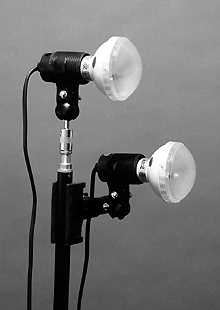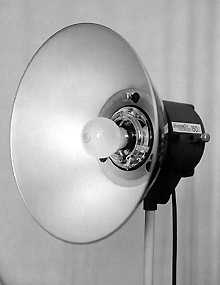 Four heads, three stands, one free-standing reflector, a softbox, brolly,
snoot, honeycomb, diffusers, coloured filters and a bag in which to put
everything p; all for less than £350. That is what Jessop offers
in its Portaflash Studio Kit 3. Two of the heads are Series 3 models (reviewed
last month); the other two are Series 2 types. The latter start this month's
round-up of selected alternatives in the low-cost flash arena.
Four heads, three stands, one free-standing reflector, a softbox, brolly,
snoot, honeycomb, diffusers, coloured filters and a bag in which to put
everything p; all for less than £350. That is what Jessop offers
in its Portaflash Studio Kit 3. Two of the heads are Series 3 models (reviewed
last month); the other two are Series 2 types. The latter start this month's
round-up of selected alternatives in the low-cost flash arena.
 Portaflash
Series 2 units are slave flashes that are based on the familiar Edison Screw
(ES) fitting. Although Jessop offers its own holders, owners of tungsten
lighting that uses ES sockets (Photax units, for example) may prefer to
use these instead. Either way, the important point is that the three Series
2 slave flashes are very, very cheap and very, very compact (see table).
Holders cost £9.99 with either a fixed 1/4" bush or a tilt head,
and £10.99 if supplied with the tilt head attached to a sprung clamp.
Accessories include a soft-box (£17.99), barn doors (£6.99) and
a diffuser/coloured filters set (£4.47 in total).
Portaflash
Series 2 units are slave flashes that are based on the familiar Edison Screw
(ES) fitting. Although Jessop offers its own holders, owners of tungsten
lighting that uses ES sockets (Photax units, for example) may prefer to
use these instead. Either way, the important point is that the three Series
2 slave flashes are very, very cheap and very, very compact (see table).
Holders cost £9.99 with either a fixed 1/4" bush or a tilt head,
and £10.99 if supplied with the tilt head attached to a sprung clamp.
Accessories include a soft-box (£17.99), barn doors (£6.99) and
a diffuser/coloured filters set (£4.47 in total).
Last month, it was
pointed out that Series 3 units have powers that are more akin to those
of camera flashguns than to those of mainstream monoblocs. That is true,
and the Series 2 units are lower powered still. Despite this, they remain
useful in certain applications. The most sensible use for Series 2 heads
is as fill-in or local lights to supplement other, more powerful, units.
A BC-ES adapter is available, so it may sometimes be possible to replace
filament lamps with Series 2 flash units when including such lights in the
picture (photographing room locations or when giving the impression of a
portrait lit only by a desk lamp, for example). But since none of the units
have sync' sockets, they cannot be tripped directly and must therefore always
be sufficiently strongly covered by other heads to ensure that they do fire,
by photocell triggering, when required.
Another way of providing compact
additional lighting to supplement a monobloc set-up is by using camera flashguns
themselves. Attaching a (very inexpensive) photocell sensor turns any flashgun
into a useful slave flash unit. To soften the lighting, a small softbox
or diffuser panel can be fitted. Such items are available from Holmes Marketing
& Distribution (LumiQuest) and Hasselblad (Photoflex) amongst others. Output
should always be set to manual control for greatest exposure consistency.
Ideally, the flashgun should offer a choice of manual power levels in order
for the output to be balanced as closely as possible to whatever other lights
are is used. Although it is stating the obvious, it is worth stressing that
the exposure effects of flashguns can be checked using conventional flash-meters
as usual.
It ought to be equally obvious that, because flashguns run from
self-contained batteries, they can be used away from mains electricity and
can be placed in isolated positions where power cables would be visible
if other lights were used. They also have very much faster flash durations,
so if you're trying to capture falling water droplets, bursting balloons,
or the like, camera flashguns are better choices than even exotic, expensive,
brief-duration monoblocs.
Mention was made earlier of fitting Jessop Portaflash
Series 2 slave units into Photax holders. This comment was aimed mainly
at owners of the older Photax lighting system, in which the lamp holder
fitted through from the back of the reflector. Owners of more recent Photax
systems have a better alternative, for Photax now uses a common reflector
mounting for both its 3200K tungsten head and its Interfit ColorFlash 75S
and 150S flash heads (which replace the previous 5500K head). This tactic
provides a very useful upgrade route for users of tungsten who wish to move
into flash, and is also useful for those who might want to mix the two light
sources.

Interfit flash
The flash heads are rather basic in their specifications,
but are quite usable nevertheless. As their model numbers suggest, the 75S
and 150S are rated at 75J and 150J respectively. This puts them one to each
side of the old 87J 5500K model and makes the more powerful unit the more
appealing. Flash output can be either full or half power, with proportional
modelling or modelling lamp off. In the case of the 150S, flash recycling
was measured at approximately 1.5s on half power, 2.5s on full. Unsurprisingly
(at this price level) there is no flash inhibiting circuitry.
Used realistically,
the 150S (in particular) performs well. A typical exposure reading for one
head fitted with a 30cm dish, is slightly better than 11 at 2m. Aesthetically,
the Photax heads look rather good on account of their polished aluminium
reflectors, which are supplied in the as-spun state (without black coatings
on their exterior surfaces). The default stands are white, rather than the
more common black finish (though black stands are available too), and are
fitted with locking clips that hold the legs closed when collapsed for transportation
or storage.
Whether or not the lights are good buys is another matter. At
£120 and £180, the 75S and 150S top the Photax range, leaving
no step up for more experienced users. Neither is there an accessory snoot
nor any grids p; though there are three reflectors. Elsewhere, one rather
nice touch is the provision of "Addalite" adaptors on lighting
stands: these allow two heads to be mounted on one stand, extending the
length of the light source and increasing the illumination level.
In their
own way, InterFit ColorFlash heads represent very good value for money.
The 150/150 two-head kit, including reflectors, stands and brollies, costs
£430 (including VAT). This puts it in almost the same price-band as
the Jessop Portaflash Studio Kit 3. There may only be two heads included,
but they do have interchangeable reflectors.
On the other hand, a single
ColorFlash 150S costs only £20 less than a Prolinca 125. The Prolinca
is very slightly less powerful, but it is the bottom rung on a very long
ladder that leads up through Elinchrom monoblocs to generator packs and
a host of specialised lights. So, for those just starting out in photography
and wanting to be able to upgrade in the future, the Prolinca looks more
attractive.
But for those who mix flash and tungsten, and who have to work
within a tight budget, Photax units make more sense.
Return to Photon July 96 contents
 Portaflash
Series 2 units are slave flashes that are based on the familiar Edison Screw
(ES) fitting. Although Jessop offers its own holders, owners of tungsten
lighting that uses ES sockets (Photax units, for example) may prefer to
use these instead. Either way, the important point is that the three Series
2 slave flashes are very, very cheap and very, very compact (see table).
Holders cost £9.99 with either a fixed 1/4" bush or a tilt head,
and £10.99 if supplied with the tilt head attached to a sprung clamp.
Accessories include a soft-box (£17.99), barn doors (£6.99) and
a diffuser/coloured filters set (£4.47 in total).
Portaflash
Series 2 units are slave flashes that are based on the familiar Edison Screw
(ES) fitting. Although Jessop offers its own holders, owners of tungsten
lighting that uses ES sockets (Photax units, for example) may prefer to
use these instead. Either way, the important point is that the three Series
2 slave flashes are very, very cheap and very, very compact (see table).
Holders cost £9.99 with either a fixed 1/4" bush or a tilt head,
and £10.99 if supplied with the tilt head attached to a sprung clamp.
Accessories include a soft-box (£17.99), barn doors (£6.99) and
a diffuser/coloured filters set (£4.47 in total). Four heads, three stands, one free-standing reflector, a softbox, brolly,
snoot, honeycomb, diffusers, coloured filters and a bag in which to put
everything p; all for less than £350. That is what Jessop offers
in its Portaflash Studio Kit 3. Two of the heads are Series 3 models (reviewed
last month); the other two are Series 2 types. The latter start this month's
round-up of selected alternatives in the low-cost flash arena.
Four heads, three stands, one free-standing reflector, a softbox, brolly,
snoot, honeycomb, diffusers, coloured filters and a bag in which to put
everything p; all for less than £350. That is what Jessop offers
in its Portaflash Studio Kit 3. Two of the heads are Series 3 models (reviewed
last month); the other two are Series 2 types. The latter start this month's
round-up of selected alternatives in the low-cost flash arena.